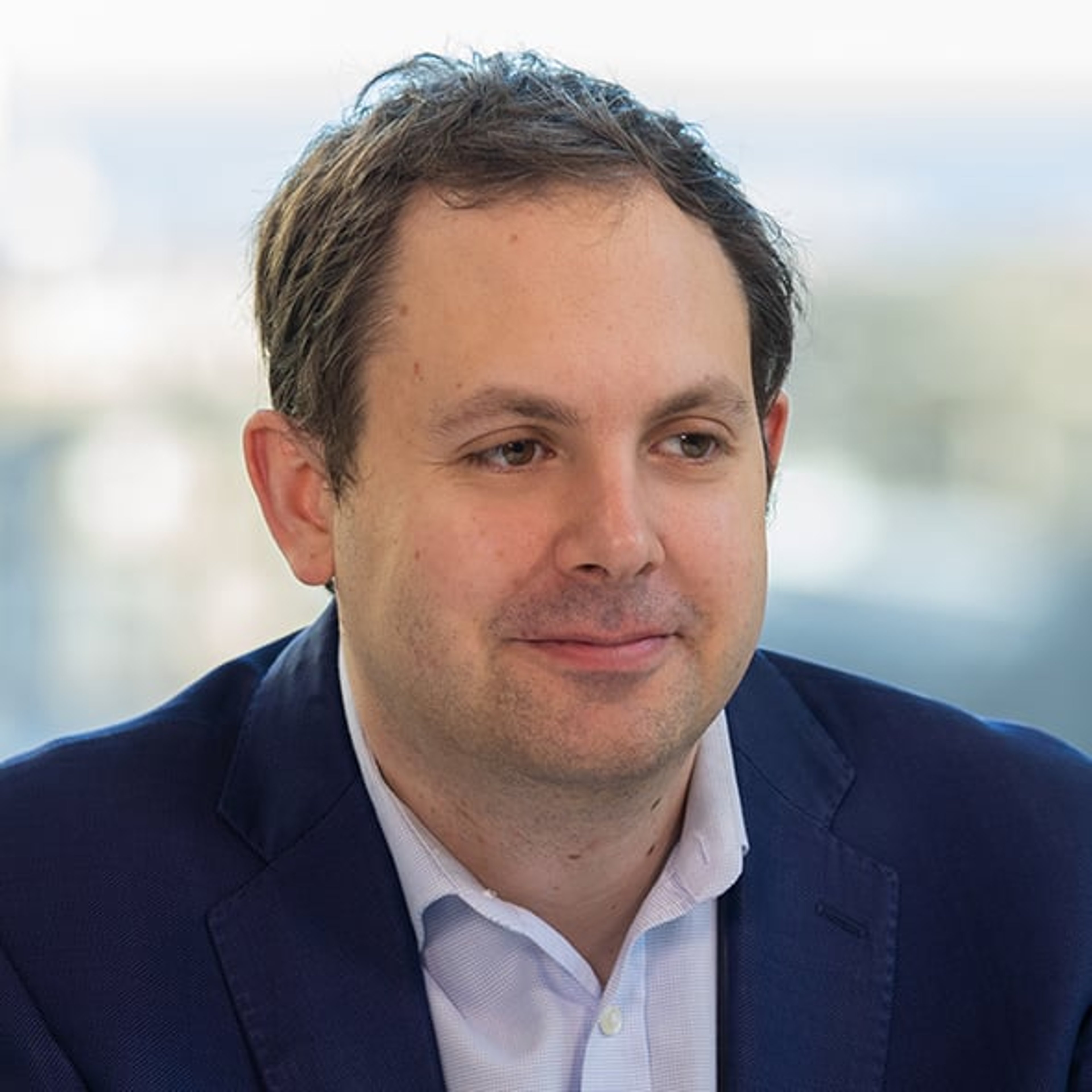
Investors should carefully consider the objectives, risks, charges and expenses of the Fund before investing. This information and other information about the Fund can be found in the prospectus and summary prospectus. For a prospectus or summary prospectus please visit our website at https://usmutualfund.bailliegifford.com. Please carefully read the Fund’s prospectus and related documents before investing. Securities are offered through Baillie Gifford Funds Services LLC, an affiliate of Baillie Gifford Overseas Limited and a member of FINRA.
A quinquennial pause for reflection
Having reached the midpoint of the 2020s, it seems fitting to pause and reflect upon the extraordinary events that have shaped the investment landscape over the past five years. This period has been marked by the first global pandemic in a century, the most rapid interest rate tightening cycle in four decades and geopolitical tensions reminiscent of the Cold War era. Meanwhile, the pace of technological change has not only continued but accelerated driven by rapid advancements in artificial intelligence (AI).
Through this tumultuous period, the investment returns have exhibited far greater volatility than we would ever have expected. The start of this decade saw the portfolio benefit tremendously from the conditions of the pandemic. The accelerated adoption of online services and ultra-accommodative monetary policy boosted both the growth and valuations of the holdings. However, they faced a sharp reversal as the pandemic waned. A normalisation of economic activity both slowed the growth of the digital holdings and caused surging inflation, leading to a historically rapid rise in interest rates, impacting the valuations of growth stocks.
The last five years have, therefore, been turbulent and testing, yet returns have still exceeded the benchmark by approximately 6 per cent per annum. We also appreciate that not all of our clients arrived before the pandemic and therefore have not benefitted from this. This performance has only been possible through the power of a few big winners held patiently and in size. Our conviction in our long-term high-growth investment philosophy has therefore not only endured but been fortified through this period. This is not to say we did not make mistakes nor that we do not need to improve. Rather, it is to make clear our unwavering conviction in our approach and its ability to deliver future outperformance if executed effectively.
There are three key parts to our investment approach:
01. Concentration
Academic research shows that concentrated portfolios tend to outperform their more diversified counterparts 1. Research indicates that while fund managers do have a few good ideas, they tend not to have that many of them. Intuitively, this makes sense;
after all, it is rare for an individual or even a team to have 50 or 100 great investment ideas. Moreover, truly great companies are rare, not plentiful. Consequently, we maintain a focused portfolio of 20–35 holdings that allows us to own only those ideas that we view as the most attractive.
Why is this hard for others to do?
Focusing on a small number of good ideas may improve long-term returns, but it usually increases short and medium-term volatility. This often leads to career risk for the fund manager and raises the potential for client losses for the investment firm. We believe we have two sources of edge that allow us to better cope with volatility. The first is internal: our century-old partnership structure which provides stability reducing the perceived career risk felt by investors. The second is external: alignment with our high-quality client base. This matters because you can only be as steadfast as the clients whose money you manage. For our clients, we usually represent a relatively small allocation alongside many other managers which provide the necessary diversification.
02. A focus on outliers
Academic research shows that value creation in the stock market is driven by a very small number of big winners 2. Most companies simply do not matter. We therefore focus on those that could matter, those that have the potential to best exploit the asymmetry of equity investing. Our Strategy seeks to identify and own as many of these outliers as we can.
Why is this hard for others to do?
It requires imagination rather than spreadsheet modelling, a willingness to embrace uncertainty and tolerance for looking very foolish when you are wrong. Investing in Tesla was for many years decried as foolhardy because it was heavily unprofitable, traded at sky-high spot multiples, making investors question the valuation, and was run by an unconventional and highly controversial founder. Had Tesla not worked it would have been deemed an obviously imprudent investment. However, it was precisely because it was uncertain and unconventional that it had the possibility of delivering extraordinary returns. When investing in outliers the mistakes you make will usually appear very embarrassing. Nonetheless, getting a single outlier right can make up for a great number of investment mistakes as demonstrated by the below:
International Concentrated Growth Equities Fund asymmetric returns

Source: Revolution, MSCI. US dollar.
Data from December 14 2017 to December 31 2024.
Some stocks were only held for part of the period. Past performance is not a guide to future returns.
03. Exceptional outcomes require time and patience
We invest with a 5–10 year time horizon, recognising that it takes time for great companies to emerge and demonstrate their value. This approach requires patience through the inevitable setbacks and resistance to taking profits too early. Academic evidence shows that progress is never a straight line, even among the best investments in stock market history – all of which have experienced brutal falls in their share price along the path to success 3. Apple has experienced three drawdowns of over 70 per cent, while Amazon has fallen over 90 per cent. In the pursuit of outliers, setbacks are de rigueur, and patience is a prerequisite.
Why is this hard for others to do?
Constant evolution
Our conviction in our investment philosophy may be steadfast, but that does not mean we cannot improve how we implement it.
We are currently focused on two improvements. The first is ensuring that we are as broad as possible in our search for outliers. This is because in investing, the worst mistakes you can make are sins of omission. These are far more harmful than the embarrassing but less impactful sins of commission. It therefore bothers us greatly that we did not own Novo Nordisk much earlier, having added it to the portfolio last year. Arguably, its potential to address the global problem of obesity first became visible as early as 2017 when it released Ozempic for type 2 diabetes. It then became increasingly obvious with the launch of Wegovy as an obesity treatment in 2021. Novo Nordisk’s shares have now risen well over 3x since 2020. Going forward, we need to ensure we are casting a sufficiently wide net in our search for outliers to ensure we are open to their appearance across different industries, company sizes and maturities. We must be open-minded as to the sources of transformational growth.
The second improvement is to ensure we devote sufficient time to evaluating not just a company's potential end state, but also the path it must navigate to reach that potential. In other words, to consider the journey as well as the destination. Sticking with the healthcare theme, we still think we were right to identify that Moderna, the mRNA biotechnology company, had outlier potential given the broad application of its technology platform to everything from the flu right the way through to cancer. Nonetheless, we failed to properly think through the impact of falling Covid-19 vaccine profits as well as the significant time and hurdles the company would face in bringing new therapeutics to market. We should have realised that the journey ahead would be bumpy and had a holding size that appropriately reflected this. Our conviction in Moderna remains, but it will likely still be a few years until our hypothesis is proven or not.
A promising backdrop for growth investors
The pandemic created a bubble in growth assets that painfully burst. When bubbles burst investors are often chastened and scarred. After the dotcom bubble burst, a generation of investors was left wary of investing in ‘risky’ internet companies. The irony, of course, is that they would have been best served spending the next two decades investing in little else. After such a difficult period for active growth managers, there is now a natural gravitational pull toward perceived safety, predictability and convention.
We feel no such pull; rather, we welcome the possibility that our own approach is becoming more distinctive from others. As the market focuses on slower but steadier growth companies beyond the US technology behemoths, it enables us to buy uncertain but potentially highly rewarding long-term growth companies at lower valuations. This is demonstrated in the premium being paid for our portfolio’s growth which is lower now than it has been for many years, relative to its own history and relative to the index. The portfolio’s price-to-earnings-growth ratio is currently 1x, which is less than half its five-year historic average and less than the index which is on 1.5x.
What matters, though, is not just the price we are being asked to pay for long-term growth businesses, but also whether the broader environment is conducive to their emergence and flourishing. Talking to the leaders of companies around the world there is a clear commonality: a belief that the pace of technological change is faster now than it has ever been. This bodes well for growth investors because change creates opportunities for existing industries to be disrupted and entirely new ones to be created. In a fast-changing world, those companies vaunted for their perceived safety and predictability can be the most at risk. In a world of change, you should want to own disruptive growth companies.
We see four large opportunities going forward within international markets
The first is the ability to own crucial parts of the supply chain for global compute (including AI). We own TSMC, the world’s increasingly dominant chip manufacturer, which is compounding earnings at 30 per cent yet trades on just 18x next year's earnings. We also own ASML, a company with a monopoly position in supplying the world with the latest lithography machines, which are arguably the most complicated in the world.
The second opportunity is the ability to own companies that are digitising emerging economies. In emerging economies, digitation is often both more nascent but also more valuable given the paucity of offline development. In Latin America, ecommerce penetration is still half the rate of the US providing a significant growth opportunity for market leader MercadoLibre. In the dynamic and fast-growing Association of Southeast Asian Nations (ASEAN) region, a similar opportunity is available for SEA. For Nubank in Latin America, the opportunity is to disrupt expensive and inefficient banking systems that fail to properly serve much of the population.
The third opportunity is the ability to own truly iconic European heritage brands such as Hermès and Ferrari, which have demonstrated profound pricing power even in the most challenging of economic environments. These are both slower-growing businesses, but we believe they are truly unique in their longevity and quality of their financial characteristics, thus still enabling outlier returns over sufficiently long time periods. Few companies might have a genuine chance of still being successful
growing businesses a century from now, but we suspect both Hermès and Ferrari are strong contenders.
The fourth and final opportunity is to benefit from the advancement of AI. We have owned NVIDIA for over seven years now and recognise that the spoils of AI have so far been highly concentrated in a small number of US tech giants. However, should the technology fulfil its potential, we expect to see value increasingly realised across a broader range of companies. AI can be thought of as an ever-improving toolkit and the companies best placed to use that toolkit will be those with large amounts of proprietary data, software expertise and a culture of innovation. In each of these dimensions, our portfolio companies should be well-placed: whether it is Nubank using AI to improve the underwriting of loans for its 100 million customers, Shopify creating an AI-powered sidekick to help merchants run their business or Spotify using AI to improve music discovery.
Final thoughts
The recent period has been unusually challenging. Although our performance over the last five years has been very strong, we recognise that when measured over the last three years starting from the peak of the pandemic, the numbers are strongly negative. As we progress through next year, our three-year performance numbers should materially improve as the starting point for measurement will begin to fall after the pandemic boom. Concurrently, our five-year numbers will start to be measured from the pandemic period leading them to worsen significantly as this volatile period works its way through our performance history.
We are encouraged to end the year on a positive trajectory having strongly outperformed the benchmark in 2024. This demonstrates both that performance is improving and that past performance was not predicated on a bygone era of low interest rates and cheap capital. Instead, it is and will remain predicated on our ability to identify, own and hold on to a small number of big winners. With the portfolio growing earnings in the last 12 months at 24 per cent, compared to the decline of 5 per cent in the index, we believe we have a portfolio of companies that are showing the necessary ingredients to deliver exceptional returns versus our benchmark in the years ahead. We greatly appreciate the trust our clients have placed in us to deliver these returns and their steadfast support through an unusually volatile first half of this decade.
1 “Best Ideas” by Cohen, Polk and Silli (2009) and “Diversification versus Concentration … and the Winner is?” by Yeung et al (2012).
2 1.3 per cent of stocks contributed for all global net wealth creation between 1990 and 2018. “Do Global Stocks Outperform US Treasury Bills?” by Bessembinder et al (2019).
3 “Extreme Stock Market Performers, Part 1: Expect Some Drawdowns”
by Bessembinder (2020).
Risk factors
This content contains information on investments which does not constitute independent research. Accordingly, it is not subject to the protections afforded to independent research and Baillie Gifford and its staff may have dealt in the investments concerned.
As with all mutual funds, the value of an investment in the fund could decline, so you could lose money.
The most significant risks of an investment in the Baillie Gifford International Concentrated Growth Equities Fund are: Investment Style Risk, Growth Stock Risk, Long-Term Investment Strategy Risk, Non-U.S. Investment Risk and Non-Diversification Risk. The Fund is managed on a bottom up basis and stock selection is likely to be the main driver of investment returns. Returns are unlikely to track the movements of the benchmark. The prices of growth stocks can be based largely on expectations of future earnings and can decline significantly in reaction to negative news. The Fund is managed on a long-term outlook, meaning that the Fund managers look for investments that they think will make returns over a number of years, rather than over shorter time periods. Non-U.S. securities are subject to additional risks, including less liquidity, increased volatility, less transparency, withholding or other taxes and increased vulnerability to adverse changes in local and global economic conditions. There can be less regulation and possible fluctuation in value due to adverse political conditions. The Fund may have a smaller number of holdings with larger positions in each relative to other mutual funds. Other Fund risks include: Asia Risk, China Risk, Conflicts of Interest Risk, Currency Risk, Emerging Markets Risk, Equity Securities Risk, Environmental, Social and Governance Risk, Focused Investment Risk, Geographic Focus Risk, Government and Regulatory Risk, Information Technology Risk, Initial Public Offering Risk, Large-Capitalization Securities Risk, Liquidity Risk, Market Disruption and Geopolitical Risk, Market Risk, New and Smaller-Sized Funds Risk, Service Provider Risk, Settlement Risk, Small-and Medium-Capitalization Securities Risk and Valuation Risk.
For more information about these and other risks of an investment in the fund, see “Principal Investment Risks” and “Additional Investment Strategies” in the prospectus. The Baillie Gifford International Concentrated Growth Equities Fund seeks capital appreciation. There can be no assurance, however, that the fund will achieve its investment objective.
The fund is distributed by Baillie Gifford Funds Services LLC. Baillie Gifford Funds Services LLC is registered as a broker-dealer with the SEC, a member of FINRA and is an affiliate of Baillie Gifford Overseas Limited.
All information is sourced from Baillie Gifford & Co and is current unless otherwise stated.
The images used in this article are for illustrative purposes only.
(Share Class K) as of 31 December, 2024
| Gross Expense Ratio | 0.89% |
| Net Expense Ratio | 0.72% |
Annualised total return as of 31 December, 2024 (%)
| 1 Year | 3 Years | 5 Years | Since Inception* | |
| The Baillie Gifford International Concentrated Growth Fund | 18.55 | -6.26 | 10.35 | 10.97 |
| MSCI ACWI ex US Index | 6.09 | 1.35 | 4.60 | 4.35 |
*Share class inception: December, 14 2017.
Source: Baillie Gifford & Co, Bank of New York Mellon, MSCI. Net of fees, US dollars.
The performance data quoted represents past performance and is no guarantee of future results. Investment return and principal value of an investment will fluctuate so that an investor’s shares, when redeemed, may be worth more or less than their original cost. Current performance may be lower or higher than the performance data quoted. For the most recent month-end performance please visit our website at www.bailliegifford.com/usmutualfund/internationalconcentratedgrowthequitiesfund
The Baillie Gifford fund’s performance shown assumes the reinvestment of dividend and capital gain distributions and is net of management fees and expenses. Returns for periods less than one year are not annualised. From time to time, certain fees and/or expenses have been voluntarily or contractually waived or reimbursed, which has resulted in higher returns. Without these waivers or reimbursements, the returns would have been lower. Voluntary waivers or reimbursements may be applied or discontinued at any time without notice. Only the Board of Trustees may modify or terminate contractual fee waivers or expense reimbursements. Fees and expenses apply to a continued investment in the funds. All fees are described in each fund’s current prospectus.
Expense Ratios: All mutual funds have expense ratios which represent what shareholders pay for operating expenses and management fees. Expense ratios are expressed as an annualized percentage of a fund's average net assets paid out in expenses. Expense ratio information is as of the Fund's current prospectus, as revised and supplemented from time to time. The net expense ratios for this fund are contractually capped (excluding taxes, sub-accounting expenses and extraordinary expenses), through April 30, 2025.
The MSCI All Country World ex US Index is a free float-adjusted market capitalization weighted index that is designed to measure equity market performance in the global developed and emerging markets, excluding the United States. This unmanaged index does not reflect fees and expenses and is not available for direct investment. The Fund is more concentrated than the MSCI ACWI ex US Index.
Top Ten Holdings
| Holdings | Fund % |
|---|---|
| 1. MercadoLibre | 11.70 |
| 2. Spotify | 10.57 |
| 3. NVIDIA | 7.08 |
| 4. TSMC | 6.67 |
| 5. Adyen | 6.25 |
| 6. ASML | 5.22 |
| 7. Hermès International | 4.41 |
| 8. Meituan | 4.35 |
| 9. Ferrari | 4.28 |
| 10. Shopify | 4.20 |
Data as of 31 December 2024.
It should not be assumed that recommendations/transactions made in the future will be profitable or will equal performance of the securities mentioned. A full list of holdings is available on request. The composition of the fund's holdings is subject to change. Percentages are based on securities at market value.
Legal Notices
Source: MSCI. MSCI makes no express or implied warranties or representations and shall have no liability whatsoever with respect to any MSCI data contained herein. The MSCI data may not be further redistributed or used as a basis for other indexes or any securities or financial products. This report is not approved, endorsed, reviewed or produced by MSCI. None of the MSCI data is intended to constitute investment advice or a recommendation to make (or refrain from making) any kind of investment decision and may not be relied on as such.
139615 10052954





